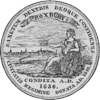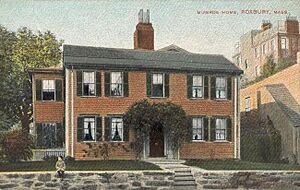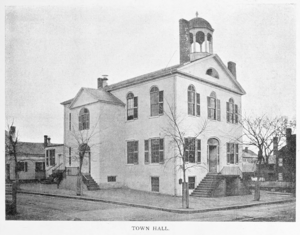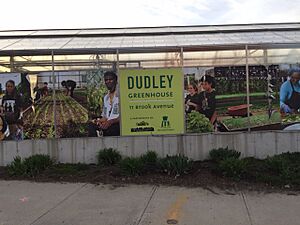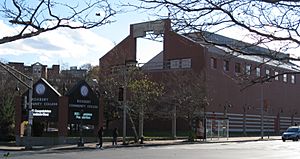Roxbury, Boston facts for kids
Quick facts for kids
Roxbury
|
||
|---|---|---|
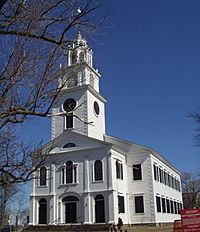
First Church of Roxbury
|
||
|
||
| Motto(s):
Saxetum Dextris Deoque Confidens (Latin)
"[In this] rocky borough, by God's right, we are confident" |
||
| Settled | 28 September 1630 | |
| Incorporated | 1630 Town 1846 City | |
| Annexed by Boston | 5 January 1868 | |
| Time zone | Eastern | |
| • Summer (DST) | Eastern | |
| Zip Code |
02119, 02121, 02118,02125
|
|
| Area code(s) | 617 / 857 | |
Roxbury is a neighborhood in the city of Boston, Massachusetts, United States. It's known as the "heart of Black culture in Boston."
Roxbury was one of the first towns founded in the Massachusetts Bay Colony in 1630. It became a city in 1846 and then joined Boston on January 5, 1868. The original Roxbury area was much larger than it is today. It included places like Longwood, Mission Hill, and parts of Symphony neighborhoods. This means areas like the Christian Science Center and Prudential Center were once part of Roxbury.
The neighborhood has many community gardens. It also has the city's first urban farm. This farm helps provide fresh, affordable food to the community. It also donates food to shelters and care facilities. Roxbury also has many centers that help young people and provide social services.
Roxbury was part of Suffolk County at first. Then it moved to Norfolk County in 1793. When it became part of Boston, it returned to Suffolk County.
Contents
- Early History of Roxbury
- Roxbury in the American Revolution
- Growth and Change in the 1800s
- Roxbury in the 20th Century
- Roxbury's Industries and Economy
- Community Development and Urban Planning
- Roxbury's Population
- Housing and Community Support
- Recreational Centers
- Education in Roxbury
- Fun Things to Do in Roxbury
- Historic Buildings to See
- Getting Around Roxbury
- Famous People from Roxbury
- Sites to Visit in Roxbury
- See also
Early History of Roxbury
Native American Roots
Before Europeans arrived, the Massachusett Native Americans lived in the Roxbury area. They had small communities and moved between inland winter homes and coastal summer homes. This allowed them to hunt, fish, and gather shellfish. Some old records mistakenly said no Native people lived here. But colonial documents and archaeological finds prove they did.
European Settlers Arrive
The Massachusetts Bay Colony started six towns, including Boston, Cambridge, and Roxbury. For over 200 years, Roxbury also included West Roxbury and Jamaica Plain. Roxbury was important because it was the only land route to the capital. This made it key for travel and trade.
In the 1600s, Roxbury had valuable resources. These included good land for farming, timber, and a brook for water and power. It also had plenty of stone for building. The area is famous for its hills and large rocks called Roxbury Puddingstone. This stone was used for many house foundations. The village was first called "Rocksberry" because of these rocky soils.
The first settlers were part of the First Church in Roxbury, started in 1632. The church was used for worship and town meetings. Reverend John Eliot was an important leader. He worked to teach Christianity to Native Americans. He also helped move them into Indian Praying Towns.
Boston was connected to the mainland by a narrow strip of land called Boston Neck. This area was home to early leaders like William Pynchon. Pynchon later left Roxbury to start Springfield, Massachusetts. Roxbury residents also grew apple orchards. They created a special apple called the Roxbury Russet, which was great for cider.
Roxbury in the American Revolution
The First Church of Roxbury was the starting point for William Dawes' "Midnight Ride." This ride happened on April 18, 1775. Dawes rode to warn Lexington and Concord about British raids. This event marked the start of the American Revolutionary War.
After the war, many people wanted to live in single-family homes away from the city. Roxbury became one of America's first suburbs. Many homes were built in the Greek Revival style. This style showed respect for the ancient Greek democracy.
Growth and Change in the 1800s
Trade grew in the early 1800s with goods like rum, salt, and fish. A horse-drawn carriage line and a railroad were built. In the 1840s, many Irish immigrants came to Massachusetts to escape the Great Famine. Some settled in Roxbury. St. Joseph's Catholic Church, built in 1846, was the first Catholic church for Irish people here.
Some homes of wealthy residents from this time still stand today. Examples include the Edward Everett Hale House and the Alvah Kittredge Mansion. Oakbend, built in 1872, is now the National Center of Afro-American Artists. As more workers were needed, old farms were divided. Single-family homes and multi-family homes were built. Trolley service started in 1887, helping people get around.
Roxbury in the 20th Century
In the early 1900s, many German immigrants settled in the Mission Hill area of Roxbury. They helped build many breweries. A Jewish community also grew in the early 20th century. Roxbury became a city in 1846 and joined Boston in 1868.
During the 1940s and 1950s, many African Americans moved from the South to northern cities. Roxbury became the main center for the African American community in Boston. Immigrants from the Caribbean, especially Jamaica and Barbados, also moved here.
Franklin Park, a large park designed by Frederick Law Olmsted, was set aside during this time. It is part of the Emerald Necklace, a seven-mile stretch of parks in Boston.
In the 1960s and 1970s, Roxbury saw a decline in its population. This was due to social changes and urban renewal projects. In 1986, a group called the Greater Roxbury Incorporation Project wanted Roxbury to become its own city. They wanted to call it "Mandela" after Nelson Mandela. This idea was not approved.
Lower Roxbury Area
Lower Roxbury was once a busy area with shops and homes. People's Market, Boston's first supermarket in a Black neighborhood, was located here.
Roxbury's Industries and Economy
In the 1600s, most people in Roxbury farmed. By the 1700s, mills and tanneries were the main industries. In the 1800s, breweries, piano makers, and iron foundries provided jobs. By the early 1900s, Roxbury had many department stores, hotels, and theaters. Factories and warehouses also grew as marshes were filled in. Today, many spaces are used for offices or shops. The community focuses on creating jobs for local residents and youth.
Community Development and Urban Planning
In the 19th century, northern Roxbury became industrial. It had many English, Irish, and German immigrants. The rest of the town remained agricultural and saw the growth of early suburbs. This led to Roxbury becoming one of Massachusetts's first cities.
In the early 20th century, Roxbury became home to new immigrants. A strong Jewish community grew around Grove Hall. A large Irish population also developed around Nubian Square (then Dudley Square). After the 1940s and 1950s, Roxbury became the center of Boston's African American community.
In the 1980s, the Orange Line subway route was moved. This led to new investments in the area. These included Roxbury Community College and Ruggles Center. Today, there is a lot of new commercial and residential development. The Fort Hill area has seen many students and young professionals move in.
The Boston Redevelopment Authority (BRA) has approved many new projects in Roxbury. These include new affordable housing units. The city is also building energy-efficient buildings. In 2013, Boston approved an urban agriculture law. Roxbury is home to the city's first urban farm, which opened in 2014.
The Dudley Street Neighborhood Initiative (DSNI) is a group that helps the community. It has a diverse board of directors, including residents, youth, and local organizations. DSNI helps provide low-income housing. They plan to build many new homes in the Dudley Triangle area.
Roxbury's Population
| Historical population | |||
|---|---|---|---|
| Census | Pop. | %± | |
| 1820 | 4,135 | — | |
| 1830 | 5,247 | 26.9% | |
| 1840 | 9,089 | 73.2% | |
| 1850 | 18,364 | 102.0% | |
| 1860 | 25,137 | 36.9% | |
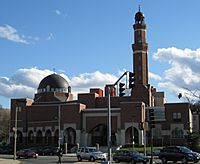
Today, Roxbury is home to a diverse community. This includes African American, Hispanic, and Asian families, as well as young professionals. The neighborhood has a population of about 59,626 people (as of 2016). Most residents are Black or African American, followed by Hispanic or Latino. Many different languages are spoken at home, including English and Spanish.
Housing and Community Support
Roxbury has many housing resources. These include government housing programs and shelters. Organizations like Boston Fair Housing help residents buy and keep their homes. MASS Housing provides financing for affordable housing. The Section 8 voucher program also helps with housing. Action for Boston Community Development offers services to help families overcome poverty.
Food and Nutrition Programs
Project Bread supports over 400 community food programs across Massachusetts. These programs include soup kitchens, food pantries, and farmers market coupons. They help children, families, and elders get fresh food. The Food Project grows produce for farmers markets and hunger relief groups. The Foodsource Hotline helps people find food resources. They also provide information about school meals and the Supplemental Nutrition Assistance Program (SNAP).
Other Community Resources
The Green House Garden helps low-income families get fresh produce. It is run by volunteers and helps fight obesity. The BCYF (Boston Center for Youth and Families) Shelburne Community Center offers many activities. These include basketball, computer classes, and teen mentoring. It also partners with the Boston Police Department to help youth.
Roxbury has a new, energy-efficient police station. The police department also created a women's basketball team to build community bonds. Project R.I.G.H.T. connects residents to community growth and economic opportunities. The ExtraHelp program is a TV show that helps students with homework and tests. Child Services of Roxbury helps troubled youth and their families. Youth Build Boston teaches young people trades and skills.
Environmental Efforts
The Environment, Energy and Open Space Cabinet works to protect the environment. They focus on energy efficiency, green buildings, and recycling. The city is converting streetlights to LED to save energy. Renew Boston Solar encourages people to install solar energy systems. They make it easier to get permits and offer financing help.
Recreational Centers
The Roxbury YMCA helps young people lead healthy lives. It is one of the largest YMCAs in the country. It offers programs in adult education, sports, and health.
The John A. Shelburne Community Center provides recreation, education, and cultural activities. The Hattie B Copper Community Center focuses on leadership for women of color.
The Reggie Lewis Center, opened in 1995, is a famous track and field facility. It hosts many high school, college, and national track meets. It also offers community programs for children and adults. These include after-school tutoring, physical activities, and arts and crafts.
Education in Roxbury
Schools for All Ages
Students in Roxbury attend Boston Public Schools (BPS). Roxbury is home to Boston Latin Academy, Madison Park Technical Vocational High School, and John D. O'Bryant School of Mathematics & Science. These are highly-regarded secondary schools.
BPS has "pilot schools" that try new ways of teaching. They have more freedom to organize classes and staff. Roxbury also has "Horace Mann Charter Schools," which are public schools with more independence. Alternative schools help students who are new to America or who need different learning options. "Turnaround schools" get extra support to improve their performance.
Colleges and Universities
Roxbury is home to Roxbury Community College. It offers Associate Degrees and certificate programs. The college has a diverse student body. Gordon-Conwell Theological Seminary's Center for Urban Ministerial Education (CUME) is also in Roxbury. It offers classes in many languages to serve its diverse students. Emmanuel College and Eastern Nazarene College also have programs in Roxbury.
Public Libraries
The Boston Public Library has the Dudley Branch Library in Roxbury. It also has the Dudley Literacy Center, which helps people learning English. The Grove Hall Branch Library is also nearby.
Other Educational Services
Boston Day and Evening Academy helps students who have struggled in school. It prepares them for graduation and college. City on a Hill Charter Public School is a network of tuition-free high schools. They help students who may not have been well-served by traditional schools. These schools help students pass state tests and go to college.
Fun Things to Do in Roxbury
Museums to Explore
Boston Children's Museum was founded in 1913. It is one of the oldest and largest children's museums in the world. It aims to inspire curiosity about science and art in young people.
The Hamill Gallery of African Art used to be in Roxbury. It had over 40,000 pieces of African art. It aimed to teach people about tribal art and its importance. The gallery closed in 2019.
Parks and Green Spaces
Roxbury has many parks and green spaces. These include the William J. Devine Memorial Golf Course and Franklin Park. Other parks include the Eliot Burying Grounds and the Puddingstone Garden. These parks have received grants to be restored and improved. Active parks like Southwest Corridor Park and Highland Park offer places to relax and play. The Elma Lewis Playhouse Park hosts concerts and events all year.
More Entertainment
The Roxbury Center for the Arts, Culture, and Trade celebrates community culture. It opened in 2005.
The Roxbury International Film Festival started in 1999. It shows films by and about people of color. It is New England's largest film festival of its kind. It also offers workshops for artists.
Since 2018, Roxbury has held the Roxbury Unity Parade. This parade celebrates the Black community and culture. The Annual Mother's Day Walk for Peace has been held since 2000. You can also see public sculptures and murals on Ruggles Street and Malcolm X Boulevard. The MainStage theater at Roxbury Community College offers workshops and public plays.
Historic Buildings to See
- Abbotsford: Built in 1872, this Victorian Gothic-style house was once part of an apple orchard estate. Today, it's a museum dedicated to Black visual arts.
- First Haitian Baptist Church: Built in 1905 as a Jewish temple, it was later sold and restored by the First Haitian Baptist Church.
- Cox Houses: Built in 1871, these marble-clad houses show the popular French style of the time. They were meant to attract middle-class families.
- Cox Building: Built in 1870, this building shows Roxbury's change from a rural town to a suburb. It had shops and hotel rooms, with homes attached.
- Edward Everett Hale House: This Greek Revival home belonged to Edward Everett Hale, a famous writer and reformer.
- Eliot Burying Ground: The oldest cemetery in Roxbury, established in 1630. Reverend John Eliot is buried here.
- First Church in Roxbury: The oldest wood-frame church in Boston, built in 1804. It is the fifth church on this site since 1632.
- Freedom House: Established in 1949, this is an important social and political gathering place for Roxbury and nearby neighborhoods.
- Hibernian Hall: Built in 1913, this was a lively Irish social club and dance hall. It now serves as the Roxbury Center of the Arts.
- Pierpont-Stony Brook Mill Site: This was a public boat landing in colonial times. It later became a large rope manufacturing mill.
- Malcolm X House: This was the home of Ella Little-Collins, sister of activist Malcolm X. He lived here in the early 1940s.
- Palladio Hall: Built in the late 1870s, this building is a rare example of Italian Renaissance commercial style in Boston.
- Shirley Eustis House: Construction began in 1747. This mansion is one of only four remaining colonial governors' mansions in the United States.
- Spooner-Lambert House: Built in 1782 for Major John Jones Spooner.
- William Lloyd Garrison House: This Greek Revival home was where William Lloyd Garrison, a leader of the anti-slavery movement, lived.
Getting Around Roxbury
The Massachusetts Bay Transportation Authority (MBTA) provides subway and bus services in Roxbury. The Silver Line stops at [[{{{station}}} (MBTA station)|{{{station}}}]], which is a bus hub. Many bus lines also serve the Roxbury community.
Famous People from Roxbury
- Jalen Adams (born 1995), basketball player
- Irving Ashby (1920–1987), jazz guitarist
- Shauna Barbosa (born ca. 1988), poet
- Edith Barrett (1907–1977), actress
- Ruth Batson (1921–2003), civil rights and education activist
- Susan Batson (born 1943), actress
- Michael Beach (born 1963), actor
- Ricky Bell (born 1967), singer
- Michael Bivins, member of R&B group New Edition
- Nathaniel Jeremiah Bradlee (1829–1888), architect
- Edward Brooke (1919–2015), U.S. senator
- Bobby Brown (born 1969), member of R&B group New Edition
- Melnea Cass (1896–1978), civil rights and community activist
- Wilhelmina Crosson (1900–1991), educator
- James Michael Curley (1874–1958), mayor of Boston
- Alan Dawson (1929–1996), jazz drummer
- Henry Dearborn (1751–1829), physician, general
- Henry Alexander Scammell Dearborn (1783–1851), U.S. representative, mayor of Roxbury
- Ronnie DeVoe, member of R&B group New Edition
- Joseph Dudley (1647–1720), colonial governor of Massachusetts
- Thomas Dudley (1576–1653), colonial governor of Massachusetts
- Ed O.G. (born 1970), hip hop artist
- John Eliot (1604–1690), minister, Bible translator
- Gustavus Esselen (1888–1952), chemist
- William Eustis (1753–1825), governor of Massachusetts
- Louis Farrakhan (born 1933), Nation of Islam leader
- Jessie Forsyth (1847/49 – 1937), temperance advocate
- Mark Frechette (1947–1975), film actor
- Margaret Foley (1875–1957), suffragist
- The G-Clefs, soul group
- William Lloyd Garrison (1805–1879), journalist, abolitionist
- Charles Dana Gibson (1867–1944), illustrator
- Ezekiel Goldthwait (1710-1782), colonial businessman
- Samuel Griswold Goodrich (1793–1860), author
- Diane Guerrero (born 1986), actress
- Guru (1966–2010), rapper
- Edward Everett Hale (1822–1909), author, reformer
- Roy Haynes (born 1925), jazz drummer
- Elma Lewis (1921–2004), arts educator
- Mel Lyman (1938–1978), harmonica player
- James Magee (1750–1801), sea captain
- Nelson Merced, state legislator
- Charles McBurney, surgeon
- Wayne Millner (1913–1976), American football player
- Liz Miranda, state legislator
- Lucy Miller Mitchell (1899–2002), educator and activist
- Shabazz Napier (born 1991), NBA player
- Patrice O'Neal (1969–2011), comedian, actor
- Oye Owolewa (born 1989), U.S. representative
- Louis Prang (1824–1909), printer, publisher
- William Pynchon (1590–1662), founder of Roxbury and Springfield
- Sylvester H. Roper (1823–1896), inventor
- Nathaniel Ruggles (1761–1819), U.S. representative
- Byron Rushing (born 1942), state legislator
- Joan Ruth (born 1904 - died?), soprano
- Kenneth Kamal Scott (born 1940), singer, dancer, actor
- Ebenezer Seaver (1763–1844), U.S. representative
- Wayne Selden Jr. (born 1994), basketball player
- William Shirley (1694–1771), colonial governor of Massachusetts
- Ebenezer Stevens (1751–1823), American Revolution activist
- Kemp Stillings (1888–1967), violinist, music teacher
- Sonny Stitt (1924–1982), jazz saxophonist
- Ellen M. Stone (1846–1927), missionary, teacher
- John L. Sullivan (1858–1918), boxing heavyweight champion
- Donna Summer (1948–2012), R&B singer
- Increase Sumner (1746–1799), governor of Massachusetts
- Ralph Tresvant (born 1968), member of R&B group New Edition
- Martha Tucker, great-grandmother of Laura Ingalls Wilder
- Darius Walker, CNN Vice President
- Jimmy Walker (1944–2007), professional basketball player
- Joseph Warren (1741–1775), physician, Revolutionary major general
- Lakiyra Williams (born 1991), rapper, poet
- Tony Williams (1945–1997), jazz drummer
- Gladys Wood (1916–2017), Boston Public Schools' first Black principal
- Malcolm X (1925–1965), Nation of Islam minister and activist
Sites to Visit in Roxbury
- Franklin Park Zoo
- Hibernian Hall
- John D. O'Bryant School of Mathematics & Science
- Madison Park Technical Vocational High School
- Nubian Square
- Roxbury Community College
- Shirley-Eustis House
See also
 In Spanish: Roxbury (Boston) para niños
In Spanish: Roxbury (Boston) para niños


